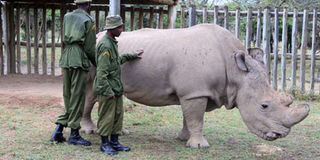Technology last hope of saving white rhino

Rangers at the Ol Pejeta Conservancy guard a white rhino at the sanctuary on April 28, 16. PHOTO | JEFF ANGOTE | NATION MEDIA GROUP
What you need to know:
- Ol Pejeta, owned by Flora and Fauna International, said on its website that in vitro fertilisation (IVF) was the last hope of saving the extremely endangered species.
- Their failure to reproduce led to a global funds appeal to pay for the planned IVF procedure, expected to cost Sh102 million.
Modern technology worth millions is now Kenya’s only hope of saving the northern white rhino from extinction.
The world’s three remaining white rhinos, kept in a highly secured part of the 90,000-acre Ol Pejeta Conservancy in Laikipia County, have failed to reproduce naturally despite the conducive environment, shattering the hopes of wildlife conservationists.
Ol Pejeta, owned by Flora and Fauna International, said on its website that in vitro fertilisation (IVF) was the last hope of saving the extremely endangered species.
The rhinos’ failure to conceive resulted in the holding of an international scientific symposium in Austria where a decision was reached that research be conducted and the findings tabled at a follow-up meeting early next year.
The rhinos were part of four that were airlifted from Czech Republic’s Dvur Kralove Zoo in December 2009 to Ol Pejeta, home of the largest black rhino sanctuary in East Africa.
Their failure to reproduce led to a global funds appeal to pay for the planned IVF procedure, expected to cost Sh102 million.
Ol Pejeta Chief Operating Officer Robert Breare and Dvur Kralove Zoo Director for International Projects Jan Stejskal registered the funds appeal on GoFundMe, which has so far raised Sh2.2 million from 430 people.
The project is administered by a team from the Kenya Wildlife Service, Ol Pejeta, the Dvur Kralove Zoo and the Ministry of Environment in the Czech Republic, Back to Africa Group and Lewa Wildlife Conservancy.
Natural propagation was ruled out by visiting Czech veterinary officers, who said the male had a low sperm count and the two females were too old.
“Artificial reproduction via in vitro fertilisation techniques and stem cell technology, though costly and complicated procedures never attempted on rhinos before, is the only hope,” they said.
The Ol Pejeta Conservancy and the Dvur Kralove Zoo said Sh80 million was needed for research.
At the Austria conference, Japanese stem cell scientist Katsuhiko Hayashi said the plan would see natural gametes extracted from the skin of the three rhinos fertilised via IVF and introduced into surrogate mothers for possible siring of fertile female northern white rhino.
Dr Hayashi is renowned globally for successful propagation of mice out of simple skin cells that were later born and grew into fertile mice that could naturally reproduce.
“The process will require the latest findings in stem cell research to be adjusted and applied to rhinos and will be the first use of the technology in wildlife conservation,” said the statement appearing on Ol Pejeta’s website.
DNA samples of a dozen northern white rhinos have been preserved in genetic banks in Berlin and San Diego and will be applied in the ensuing project.





